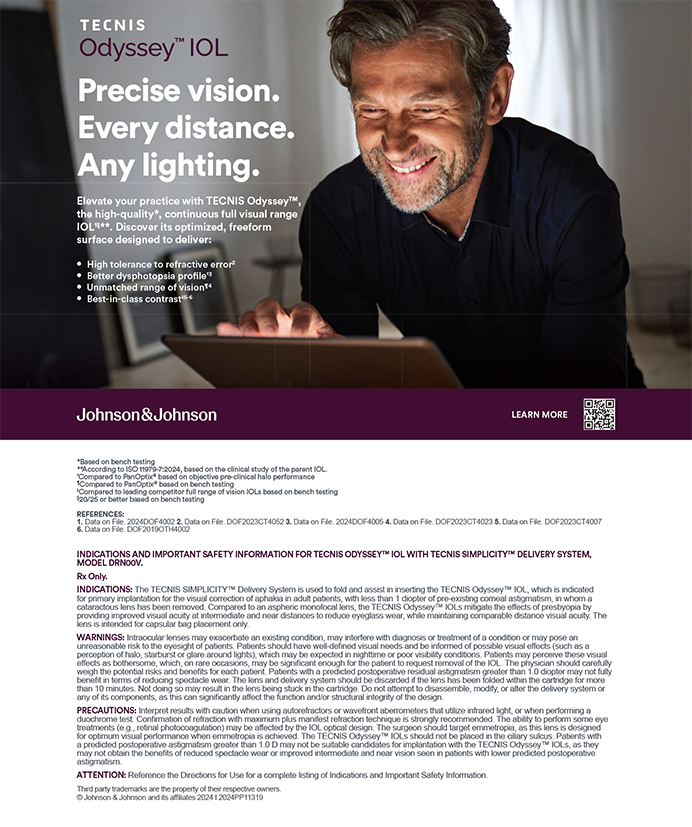TThe weakened cornea is one of the most challenging conditions for surgeons to recognize prior to performing LASIK or to treat after LASIK. Naturally occurring keratoconus can be equally challenging to manage.
BACKGROUND
To understand how to strengthen the cornea, one must understand how the cornea becomes weakened by keratoectasia and keratoconus. Young patients have a propensity to produce high levels of reactive oxygen species (free radicals) in the cornea. Superoxide dismutase and other enzymes typically prevent the accumulation of these free radicals. Some patients are unable to produce these protective enzymes, however. As a result, the free radicals accumulate, causing damage to the structural integrity of the cornea.1,2 Corneal thinning and weakening can ensue, and the cornea may herniate and steepen due to the biomechanics of IOP-induced strain on the tissue. In other words, keratoconus develops. Outlining this process illustrates why my colleague and I have been able to reverse early ectasia only by lowering IOP with glaucoma drops.3
Free radicals in the cornea have been shown to increase with exposure to sunlight and eye rubbing.4 Ophthalmologists therefore recommend that all patients with keratoconus wear sunglasses outside and avoid rubbing their eyes.
INTACS
Surgeons such as myself have found Intacs (Addition Technology, Inc., Des Plaines, IL) to be useful for reversing some of the effects of keratoectasia and keratoconus.5 Although Intacs have been a powerful tool, these ring segments have limitations. First, Intacs do not affect the biochemical substance of the corneal tissue. Second, there is a limit to how much corneal flattening (reversal of keratoectasia and keratoconus) the segments can achieve.
CORNEAL COLLAGEN CROSSLINKING WITH RIBOFLAVIN
About the Procedure
A new treatment for keratoconus increases collagen by applying a one-time-only topical dose of riboflavin drops to the cornea and exposing the cornea to a low amount of ultraviolet A (UVA) light.6 The activated riboflavin enhances corneal strength and integrity by increasing collagen crosslinking, as proven experimentally and published in the peer-reviewed literature.7,8
This riboflavin/UVA therapy has been safe thus far. There have been no reported complications in the crystalline lens or retina due to the limitation of UVA transmission through the cornea. In a 3-year study of patients with actively progressing keratoconus, the pattern of increasing mean keratometry values was not only halted, but it was also reversed and flattened by a mean of 2.00D. That result persisted during the 3-year follow-up period.6
My Experience
In early January 2004, we began using riboflavin/UVA treatments in patients with compromised corneal integrity. We named the modified procedure C3-R (corneal collagen crosslinking with riboflavin). The causes of reduced corneal integrity in our treated patients included LASIK-induced ectasia and keratoconus. To our knowledge, these C3-R procedures represent the first riboflavin/UVA treatments performed in North America for keratoconus, and our C3-R treatments combined with the prior and simultaneous placement of Intacs constitute the first-ever such treatments. The C3-R treatment is a one-time, 30-minute procedure. To date, we have not found it necessary to repeat it.
In our patients with progressive corneal steepening from both keratoectasia and keratoconus, progression has halted. In those with prior Intacs placement whose corneal steepening has continued to progress due to active keratoconus, we have observed the same halting pattern. In some cases, we saw not only stabilization but also a reversal of corneal steepening as early as 1 day postoperatively that persisted on subsequent follow-up visits. In cases of Intacs insertion for keratoconus followed immediately by C3-R treatment on the same day, we observed more than 10.00D of corneal flattening in some cases, a greater degree of flattening than with Intacs alone (Figure 1).
CONCLUSION
C3-R treatments alone and combined with Intacs implantation are allowing patients better and easier contact lens fittings (RGP and soft toric) as well as improved vision and comfort. The ability to permanently strengthen the inherently weakened cornea is a major advance in the management of these cases. C3-R treatments provide real hope for many patients with keratoectasia and keratoconus. My colleagues and I are currently compiling longer-term results of the procedure.
Brian S. Boxer Wachler, MD, is Director of the Boxer Wachler Vision Institute in Beverly Hills, California. He states that he holds no financial interest in the products, technologies, or companies mentioned herein. Dr. Boxer Wachler may be reached at (310) 860-1900; bbw@boxerwachler.com.
1. Brown DJ, Lin B, Chwa M, et al. Elements of the nitric oxide pathway can degrade TIMP-1 and increase gelatinase activity. Mol Vis. 2004;10:281288.2. Buddi R, Lin B, Atilano SR, et al. Evidence of oxidative stress in human corneal diseases. J Histochem Cytochem. 2002;50:341-351.
3. Hiatt J, Boxer Wachler BS. Reversal of LASIK-induced ectasia with intraocular pressure reduction. Paper presented at: The ASCRS/ASOA Symposium on Cataract, IOL and Refractive Surgery; May 3, 2004; San Diego, CA.
4. Kenney C. Role of oxidative stress in keratoconus. Paper presented at: The University of California–Irvine Ophthalmology Meeting; February 7, 2004; Irvine, CA.
5. Boxer Wachler BS, Christie JC, Chou B, et al. Intacs for the treatment of keratoconus. Ophthalmology. 2003;110:1031-1040.
6. Wollensak G, Spoerl E, Seiler T. Riboflavin/ultraviolet-A-induced collagen crosslinking for the treatment of keratoconus. Am J Ophthalmol. 2003;135:620-627.
7. Wollensak G, Spoerl E, Seiler T. Stress-strain measurements of human and porcine corneas after riboflavin-ultraviolet-A-induced cross-linking. J Cataract Refract Surg. 2003;29:1780-1785.
8. Wollensak G, Wilsch M, Spoerl E, Seiler T. Collagen fiber diameter in the rabbit cornea after collagen crosslinking by riboflavin/UVA. Cornea. 2004;23:503-507.


